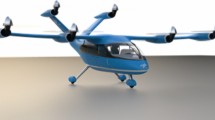Abstract
This paper presents a methodology to evaluate the vertiport performance by analyzing the average waiting time for electric vertical take-off and landing (eVTOL) vehicles to use the vertiport. A series of analytical processes for vertiport design, demand prediction, and performance analysis is presented. To design the vertiport layout, we propose a novel algorithm that evaluates the surrounding obstacles by considering current regulations. The potential demand for air taxi services by urban air mobility (UAM) as multimodal transportation is predicted by a discrete choice model that estimates the probability of choosing an air taxi service given the time saving of UAM. Then, the sensitivity of demand was analyzed for the catchment area, travel cost, and the number of passengers on board. The sensitivity analysis showed that the demand for UAM was sensitive to all factors considered. Vertiport performance is evaluated by comparing the expected number of operations derived from the UAM demand to the vertiport capacity. The proposed methodology was applied to a vertiport in the Seoul metropolitan area for the initial UAM operations. The results show that having one less gate significantly increases the waiting time of the UAM when the utilization factor of the waiting queue is high. However, the average waiting time is less than 20 min (the maximum hover time of eVTOL vehicles) if the vertiport has a sufficient number of gates, depending on the traffic volume of UAM. Therefore, it is essential to determine the number of gates considering the expected traffic volume to ensure safe UAM operations.














Similar content being viewed by others
Change history
13 September 2022
A Correction to this paper has been published: https://doi.org/10.1007/s42405-022-00524-w
Abbreviations
- ASC:
-
alternative specific constant
- CBD:
-
central business district
- eVTOL:
-
electric vertical takeoff and landing
- FAA:
-
Federal Aviation Administration
- FATO:
-
final approach and take-off area
- KTDB:
-
Korea Transport Database
- MD:
-
maximum dimension
- MNL:
-
multinomial logit
- ODM:
-
on-demand mobility
- TAZ:
-
traffic analysis zone
- TLOF:
-
touchdown and liftoff area
- TTS:
-
tip-to-tip span
- UAM:
-
urban air mobility
- \(C_\text {gate}\) :
-
Gate capacity
- \(C_\text {taxiway}\) :
-
Taxiway capacity
- \(C_\text {TLOF}\) :
-
TLOF capacity
- \(C_\text {vertiport}\) :
-
Vertiport capacity
- \(F_\text {UAM}\) :
-
Fare of UAM vehicle
- \(N_\text {gate}\) :
-
Number of gates in vertiport
- \(N_\text {TLOF}\) :
-
Number of TLOFs in vertiport
- \(P_\text {UAM}\) :
-
Probability of choosing UAM trip (i.e., modal share of UAM)
- \(P_{0}\) :
-
Probability of having no vehicles in queue
- R :
-
Radius of catchment area
- \(\text {TC}_{m}\) :
-
Travel cost of mode m, \(\forall m \in \mathcal {M}\)
- \(\text {TT}_\text {auto, access}\) :
-
Access time by automobile
- \(\text {TT}_\text {auto, egress}\) :
-
Egress time by automobile
- \(\text {TT}_\text {eVTOL}\) :
-
Cruising time of eVTOL vehicle from departure vertiport to arrival vertiport
- \(\text {TT}_{m}\) :
-
Travel time of mode m, \(\forall m \in \mathcal {M}\)
- \(\text {TT}_\text {UAM}\) :
-
Total travel time of multi-modal UAM trip
- \(V_{m}\) :
-
Utility value of mode m, \(\forall m \in \mathcal {M}\)
- \(V_\text {UAM}\) :
-
Utility value of UAM trip
- \(W_{q}\) :
-
Average waiting time for vehicle in queue
- a :
-
Length of vertiport candidate site
- b :
-
Width of vertiport candidate site
- h :
-
Height of vertiport candidate site
- \(n_\text {PAX}\) :
-
Number of passengers on board a UAM vehicle
- \(t_{\text {arr}}\) :
-
Mean elapsed time for arrival operation of UAM vehicle
- \(t_{\text {dep}}\) :
-
Mean elapsed time for departure operation of UAM vehicle
- \(t_{\text {gate}}\) :
-
Mean elapsed time for turnaround of UAM vehicle
- \(t_{\text {taxi}}\) :
-
Mean elapsed time for taxi operation of UAM vehicle
- \(t_{\text {window}}\) :
-
Time window
- \(\alpha ^{\text {time}}_{m}\) :
-
Coefficient of travel time of mode m, \(\forall m \in \mathcal {M}\)
- \(\alpha ^{\text {cost}}_{m}\) :
-
Coefficient of travel cost of mode m, \(\forall m \in \mathcal {M}\)
- \(\lambda \) :
-
Arrival rate of vehicles approaching vertiport
- \(\mu \) :
-
Service rate of vertiport
- \(\rho \) :
-
Queue utilization factor
- \(\Theta \) :
-
Set of all possible approach/departure path angles
- \(\mathcal {E}\) :
-
Set of vertiport elements (e.g., TLOF, gate, and taxiway)
- \(\mathcal {M}\) :
-
Set of available transport modes (e.g., UAM, public transport, private car)
References
Bacchini A, Cestino E (2019) Electric vtol configurations comparison. Aerospace 6(3):26. https://doi.org/10.3390/aerospace6030026
Balac M, Vetrella AR, Rothfeld R et al. (2019) Demand estimation for aerial vehicles in urban settings. IEEE Intelligent Transportation Systems Magazine 11(3):105–116. https://doi.org/10.1109/MITS.2019.2919500
Binder R, Garrow LA, German B et al. (2018) If you fly it, will commuters come? a survey to model demand for evtol urban air trips. In: 18th AIAA Aviation Technology, Integration, and Operations Conference, p 2882. https://doi.org/10.2514/6.2018-2882
Bulusu V, Onat EB, Sengupta R et al (2021) A traffic demand analysis method for urban air mobility. IEEE Trans Intell Transport Syst 22(9):6039–6047. https://doi.org/10.1109/TITS.2021.3052229
Corgan (2019) CONNECT EVOLVED. https://www.corgan.com/wp-content/uploads/2019/06/20190612_UberBook_Spreads_REDUCED-FOR-WEB.pdf. Accessed 8 November 2021
De Neufville R, Odoni A (2003) Airport systems. Planning, design and management. McGraw-Hill, New York
Deloitte (2016) The future of mobility: What’s next. https://www2.deloitte.com/tr/en/pages/consumer-industrial-products/articles/future-of-mobility-whats-next.html. Accessed 28 November 2021
EmbraerX (2021) Urban Air Traffic Management Concept of Operations. Tech. rep., https://embraerx.embraer.com/global/en/uatm. Accessed 8 December 2021
Ertürk MC, Hosseini N, Jamal H et al. (2020) Requirements and technologies towards uam: Communication, navigation, and surveillance. In: 2020 Integrated Communications Navigation and Surveillance Conference (ICNS), pp 2C2-1, https://doi.org/10.1109/ICNS50378.2020.9223003
Federal Aviation Administration (2012) Heliport Design (AC 150/5390-2C). https://www.faa.gov/airports/resources/advisory_circulars/index.cfm/go/document.current/documentnumber/150_5390-2. Accessed 6 November 2021
Federal Aviation Administration (2020) FAA Urban Air Mobility Concept of Operations v1.0. https://www.faa.gov/airports/resources/advisory_circulars/index.cfm/go/document.current/documentnumber/150_5390-2. Accessed 6 November 2021
Fu M, Rothfeld R, Antoniou C (2019) Exploring preferences for transportation modes in an urban air mobility environment: Munich case study. Transport Res Record 2673(10):427–442. https://doi.org/10.1177/0361198119843858
Garrow LA, German B, Mokhtarian P et al. (2019) A survey to model demand for evtol urban air trips and competition with autonomous ground vehicles. In: AIAA Aviation 2019 Forum, p 2871, https://doi.org/10.2514/6.2019-2871
Greenblatt JB, Shaheen S (2015) Automated vehicles, on-demand mobility, and environmental impacts. Curr Sustainable Renewable Energy Rep 2(3):74–81. https://doi.org/10.1007/s40518-015-0038-5
Guerreiro NM, Hagen GE, Maddalon JM et al. (2020) Capacity and throughput of urban air mobility vertiports with a first-come, first-served vertiport scheduling algorithm. In: AIAA Aviation 2020 Forum, p 2903. https://doi.org/10.2514/6.2020-2903
Haan J, Garrow LA, Marzuoli A et al. (2021) Are commuter air taxis coming to your city? a ranking of 40 cities in the united states. Transport Res Part C: Emerg Technol 132:103392. https://doi.org/10.1016/j.trc.2021.103392
Hillier FS (2012) Introduction to operations research. Tata McGraw-Hill, New York
International Civil Aviation Organization (2020) ANNEX 14 Aerodromes Volume 2 Heliports. https://store.icao.int/en/annex-14-aerodromes-volume-ii-heliports. Accessed 18 January 2022
Jang S (2019) A study on the effect of travel time and cost by means on the mode and destination choice of a commuter by the household income class. J Korea Plann Assoc 54(1):52–66. https://doi.org/10.17208/jkpa.2019.02.54.1.52
Kim SH (2019) Receding horizon scheduling of on-demand urban air mobility with heterogeneous fleet. IEEE Trans Aerospace Electron Syst 56(4):2751–2761. https://doi.org/10.1109/TAES.2019.2953417
Kim YM, Schonfeld P, Rakas J (1995) Vertiport capacity-analysis methods. Maryland Univ College Park Dept of Civil Engineering, Tech. rep
Kleinbekman IC, Mitici M, Wei P (2020) Rolling-horizon electric vertical takeoff and landing arrival scheduling for on-demand urban air mobility. J Aerospace Inf Syst 17(3):150–159. https://doi.org/10.2514/1.I010776
Korea Transport Institute (2018) Passenger origin-destination travel volume data. https://www.ktdb.go.kr/www/selectPbldataChargerWebList.do?key=12 &searchClStepCode=103. Accessed 17 November 2021
Lim E, Hwang H (2019) The selection of vertiport location for on-demand mobility and its application to Seoul metro area. Int J Aeronaut Space Sci 20(1):260–272. https://doi.org/10.1007/s42405-018-0117-0
Luce RD (2012) Individual choice behavior: a theoretical analysis. Wiley, New York
McFadden D (1973) Conditional logit analysis of qualitative choice behavior. University of California at Berkeley, Institute of Urban and Regional Development, Berkeley
Ministry of Land, Infrastructure and Transport (2020) Korea urban air mobility road map. https://www.korea.kr/common/download.do?fileId=191880506 &tblKey=GMN. Accessed 13 November 2021
MITRE (2018) Urban Air Mobility landscape report: Initial examination of a new air transportation system. https://www.mitre.org/publications/technical-papers/urban-air-mobility-landscape-report. Accessed 14 November 2021
Mueller ER, Kopardekar PH, Goodrich KH (2017) Enabling airspace integration for high-density on-demand mobility operations. In: 17th AIAA Aviation Technology, Integration, and Operations Conference, p 3086. https://doi.org/10.2514/6.2017-3086
NASA (2018) Urban Air Mobility market study. https://ntrs.nasa.gov/citations/20190001472. Accessed 15 November 2021
NASA (2020) UAM Vision Concept of Operations (ConOps) UAM Maturity Level (UML) 4. https://ntrs.nasa.gov/citations/20205011091. Accessed 14 November 2021
NAVER (2021) Naver Map. https://map.naver.com/v5. Accessed 25 November 2021
NUAIR (2021) High-Density Automadted Vertiport Concept of Operations. Tech. rep., NASA, https://ntrs.nasa.gov/citations/20210016168. Accessed 6 December 2021
Pradeep P, Wei P (2018) Heuristic approach for arrival sequencing and scheduling for evtol aircraft in on-demand urban air mobility. In: 2018 AIAA/IEEE 37th Digital Avionics Systems Conference (DASC), pp 1–7. https://doi.org/10.1109/DASC.2018.8569225
Preis L (2021) Quick sizing, throughput estimating and layout planning for vtol aerodromes–a methodology for vertiport design. In: AIAA Aviation 2021 Forum, p 2372, https://doi.org/10.2514/6.2021-2372
Rimjha M, Hotle S, Trani A et al. (2021) Commuter demand estimation and feasibility assessment for urban air mobility in northern California. Transport Res Part A: Policy Pract 148:506–524. https://doi.org/10.1016/j.tra.2021.03.020
Roy S, Kotwicz Herniczek MT, German BJ et al. (2021) User base estimation methodology for a business airport shuttle air taxi service. J Air Transport 29(2):69–79. https://doi.org/10.2514/1.D0216
Song K, Yeo H, Moon JH (2021) Approach control concepts and optimal vertiport airspace design for urban air mobility (uam) operation. Int J Aeronaut Space Sci 22:982–994. https://doi.org/10.1007/s42405-020-00345-9
Straubinger A, Rothfeld R, Shamiyeh M et al. (2020) An overview of current research and developments in urban air mobility-setting the scene for uam introduction. J Air Transport Manag 87:101852. https://doi.org/10.1016/j.jairtraman.2020.101852
Taylor M, Saldanli A, Park A (2020) Design of a vertiport design tool. In: 2020 Integrated Communications Navigation and Surveillance Conference (ICNS), pp 2A2-1. https://doi.org/10.1109/ICNS50378.2020.9222989
Thipphavong DP, Apaza R, Barmore B et al. (2018) Urban air mobility airspace integration concepts and considerations. In: 18th AIAA Aviation Technology, Integration, and Operations Conference, p 3676. https://doi.org/10.2514/6.2018-3676
Uber (2016) Uber elevate: Fast-forwarding to a future of on-demand urban air transportation. https://uberpubpolicy.medium.com/fast-forwarding-to-a-future-of-on-demand-urban-air-transportation-f6ad36950ffa. Accessed 28 November 2021
Uber (2019) Uber Air Vehicle Requirements and Missions. Tech. rep., Uber, https://www.uber.com/us/en/elevate. Accessed 23 December 2021
Vascik PD, Hansman RJ (2019) Development of vertiport capacity envelopes and analysis of their sensitivity to topological and operational factors. In: AIAA Scitech 2019 Forum, p 0526. https://doi.org/10.2514/6.2019-0526
Vascik PD, Hansman RJ, Dunn NS (2018) Analysis of urban air mobility operational constraints. J Air Transport 26(4):133–146. https://doi.org/10.2514/1.D0120
Yedavalli PS, Onat E, Peng X et al. (2021) Assessing the value of urban air mobility through metropolitan-scale microsimulation: A case study of the san francisco bay area. In: AIAA AVIATION 2021 Forum, p 2338. https://doi.org/10.2514/6.2021-2338
Zelinski S (2020) Operational analysis of vertiport surface topology. In: 2020 AIAA/IEEE 39th Digital Avionics Systems Conference (DASC), pp 1–10. https://doi.org/10.1109/DASC50938.2020.9256794
Acknowledgements
This work was supported by 2021 Korea Aerospace University faculty research grant.
Author information
Authors and Affiliations
Corresponding author
Ethics declarations
Conflict of interest
On behalf of all authors, the corresponding author states that there is no conflict of interest.
Additional information
Publisher's Note
Springer Nature remains neutral with regard to jurisdictional claims in published maps and institutional affiliations.
In this article the name of Hyeon-Mi Kim has been updated to Hyeonmi Kim.
Rights and permissions
Springer Nature or its licensor holds exclusive rights to this article under a publishing agreement with the author(s) or other rightsholder(s); author self-archiving of the accepted manuscript version of this article is solely governed by the terms of such publishing agreement and applicable law.
About this article
Cite this article
Park, B.T., Kim, H. & Kim, S.H. Vertiport Performance Analysis for On-Demand Urban Air Mobility Operation in Seoul Metropolitan Area. Int. J. Aeronaut. Space Sci. 23, 1065–1078 (2022). https://doi.org/10.1007/s42405-022-00505-z
Received:
Revised:
Accepted:
Published:
Issue Date:
DOI: https://doi.org/10.1007/s42405-022-00505-z




